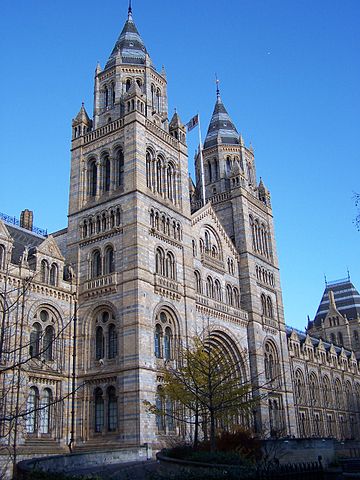
In part 4 of my marathon post on “Searching for F. E. Dean,” I mentioned a letter published in the August 18, 1922, issue of the New Mexico weekly Fort Sumner Leader, by someone with the surname of Smith (the initials are unclear). Attacking the superintendent of the Fort Sumner schools, F. E. Dean, Smith invoked a number of authorities in the service of claiming that evolution was scientifically bankrupt. Winterton Curtis, a friend of Dean from his student days at the University of Missouri, wrote to at least two of those authorities, William Bateson (discussed in part 2) and Woodrow Wilson (discussed in part 1), and used their indignant responses in his undelivered testimony at the Scopes trial in 1925. Also cited by Smith was a “Dr. Etheridge, Fossi[l]ologist of the British Museum”; the Oxford English Dictionary vouches for “fossilologist,” although “paleontologist” is of course the more usual term.
Dr. Etheridge is a familiar if mysterious figure in the creationist literature. Indeed, commenting on “Searching for F. E. Dean,” Gary Hurd recognized the name and asked whether Smith was quoting a still-popular passage attributed to Etheridge: “Nine-tenths of the talk of evolutionists is sheer nonsense, not founded on observation and wholly unsupported by facts. This museum is full of proofs of the utter falsity of their views. In all this great museum, there is not a particle of evidence of the transmutation of species.” Indeed he was, although he rendered it as: “Nine-tenths of the talk of Evolution is sheer nonsense, not founded on observation and wholly unsupported by facts, this Museum is full of proofs of the utter falsity of their views.” The proofreading at the Fort Sumner Leader was evidently not of the highest quality, so it’s unclear whether the divergence between the quotations is Smith’s or the typesetter’s fault.
Smith wasn’t the only antievolutionist in 1922 to quote Etheridge on the absence of evidence for evolution; William Jennings Bryan himself did so in his book In His Image, for example. But the passage is substantially older. Ronald L. Numbers, in The Creationists (1992), notes that Luther T. Townsend’s pamphlet Collapse of Evolution (1905), published by the American Bible League, “assembled one of the earliest—and most frequently cribbed—lists in order to prove that ‘the most thorough scholars, the world’s ablest philosophers and scientists, with few exceptions, are not supporters, but assailants of evolution.’” On Townsend’s list were such scientists as Louis Agassiz, Arnold Guyot, John William Dawson, Lionel S. Beale, Rudolf Virchow, Albert Fleischmann, and “Dr. Etheridge, of the British Museum, one of England’s most famous experts in fossilology.” There’s that word again—and there’s that lack of a given name again.
As quoted by Townsend, Etheridge says, “In all this great museum there is not a particle of evidence of transmutation of species. Nine-tenths of the talk of evolutionists is sheer nonsense, not founded on observation and wholly unsupported by fact. This museum is full of proofs of the utter falsity of their views.” Note how the sentences are in a different order than in Smith’s letter. Numbers observes, “The content of Etheridge’s statement varied from work to work, and its source remained unidentified, except for Alexander Patterson’s comment that Etheridge was answering a question put to him by a Dr. George E. Post.” Alexander Patterson was a Presbyterian evangelist at the Moody Bible Institute; he and Townsend were both in Dwight Moody’s circle. In his The Other Side of Evolution (1903), he called Etheridge “examiner of the British Museum,” and attributed to him the first and third, but not the second, sentence of the passage as quoted by Townsend.
Well, who was Dr. Etheridge, examiner of or fossilologist at the British Museum? In 1922, James H. Snowdon of the Western Theological Seminary wrote to the British Museum to ask. The Museum’s director Sidney F. Harmer responded, “This quotation, or a paraphrase of it, is more or less familiar to us, and it is not long since I had to answer another enquiry on the subject from your country. I believe the Dr. Etheridge in question to have been Robert Etheridge, Junr., who was Assistant Keeper of Geology in this Museum from 1881 to 1891. The remainder of his life was spent in Australia, and he died in 1920.” We know the details of the Snowdon/Harmer correspondence, by the way, because Winterton Curtis—in whom I am increasingly recognizing a kindred spirit—published it in his “Three Letters Bearing upon the Controversy over Evolution” in the journal Science in 1925. The other two letters were Wilson’s and Bateson’s.
Harmer also told Snowdon that he didn’t know the provenance of the passage attributed to Etheridge (“we should not think it worth while spending much time for looking for it”) and disavowed it on behalf of the British Museum: “While differences of opinion may exist as to the nature of the causes which have induced Evolution in animals and plants, it is generally admitted that the theory of Evolution, irrespective of the way in which it has been brought about, constitutes the groundwork which entitles Biology to be considered a Science.” Numbers cites and quotes from the letter in The Creationists. Elsewhere (in “Creation, Evolution, and Holy Ghost Religion,” reprinted in his Darwinism Comes to America [1998]) Numbers editorializes on Etheridge’s career, describing him as “a little-known assistant keeper of geology” and saying he “spent his last years in obscurity in Australia.” But was Harmer right? That will be the topic of part 2.

